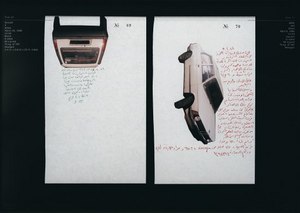This is an archive of the ArtCat Zine, 2007-2009. Please visit our new project, IDIOM.
Gorging On Images: The Archive in 20th Century Photography

Gorging On Images: The Archive in 20th Century Photography
A Lecture by Sven Spieker
7:45pm Monday 11 February 2008
NYU Silver Center, Room 300
100 Washington Square East (entrance on Waverly Place)
In his 1986 essay The Body and the Archive, Allan Sekula asserts that the analytic methodologies of phrenology and physiognomy applied, in the latter half of the 19th century, to the photographic archive constructed the very parameters of the data they promised to analyze and interpret. This is to say, it is an archive's structure that makes possible, at its inception, the differentiation of the constituting sets, or bodies, of knowledge. The archival impulse in this sense, Sekula goes on, is reductive at its essence; criminal photography and the desire to create a sort of dictionary of photographs, phrenological types, and so on is a desire to index the world in a positivist, universal mathematical language — a geometric representation of forms. The model of the archive then may be a key structure to thinking about power and the 20th century, as Hal Foster has suggested the concept is instrumental to a Deleuzean understanding of societies of control in which, as Sekula also points out, the archive becomes a crucial apparatus for maintaining and exercising of modern power.
The archive similarly, consequent perhaps to its currency in the fields of the continental philosophy and critical studies of the past 40 years — as well as the apprehensible model it provides for describing bureaucratic systems of control or sites of media production, reproduction, and circulation — has become a voguish topic in contemporary art discourse. Practitioners, too, have taken on the form: from Rodchenko to Warhol to Broodthaers, the history of 20th century art is rife with examples of the cataloging, organizing, and preserving impulse of the archivist, or, artist as archivist. Tonight at NYU, Slavic studies scholar Sven Spieker will present a lecture entitled Gorging on Images: The Archive in Contemporary Photography, focusing on the "archival turn" in 20th century photographic production, as well as its remnants in contemporary art. From the press release:
The archive in contemporary photography—from Gerhard Richter to Susan Hiller and Tacita Dean—oscillates between the pathos of total inclusiveness and the specter of radical dispersion and discontinuity. In this lecture Spieker will trace this double orientation: first to the 19th-century (photo) archive with its rhetoric of preservation and identification, and second to what has been referred to as the early 20th century’s turn towards archival forms of organization as a result of the waning of the aesthetic of shock during the 1920s (photomontage). Using two seminal essays in the history of photography— Alexander Rodchenko’s ““Against the Synthetic Portrait, for the Snapshot” (1928) and Sigfried Kracauer’s“Photography” (1927)—he will demonstrate that this archival turn, whose impact on contemporary photographic practice is considerable, was not without its own internal fissures and contradictions.
ZINE
HOME
TIPS / COMMENTS
CATEGORIES
CONTRIBUTORS
- Greg Afinogenov
- B. Blagojevic
- Adda Birnir
- Susannah Edelbaum
- Julie Fishkin
- Paddy Johnson
- Jessica Loudis
- Christopher Reiger
- Andrew Robinson
- Peter J. Russo
- Blythe Sheldon
- S.C.Squibb
- Hrag Vartanian
